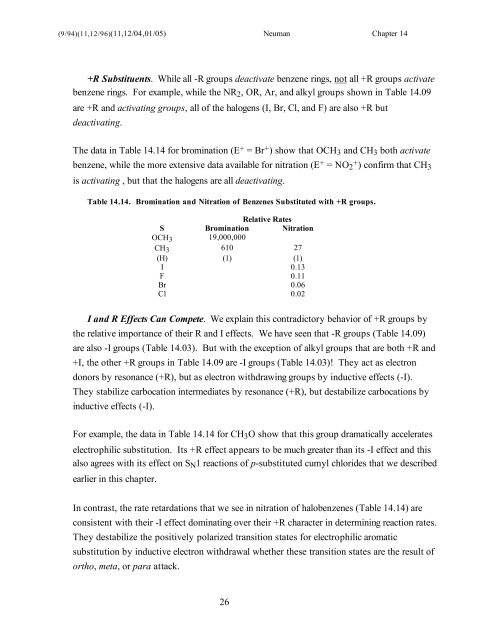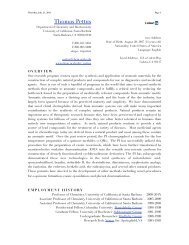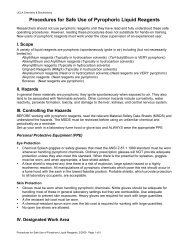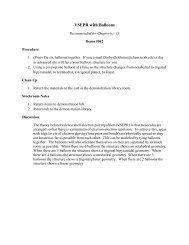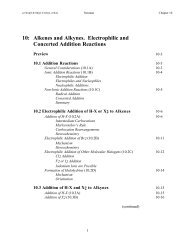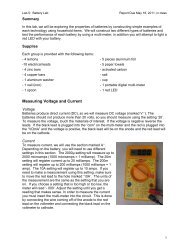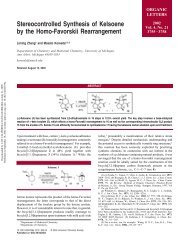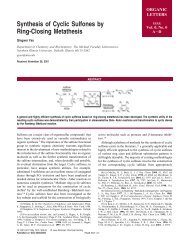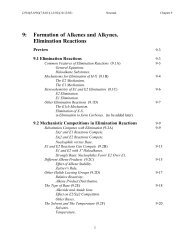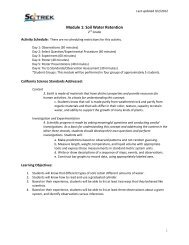14: Substituent Effects
14: Substituent Effects
14: Substituent Effects
Create successful ePaper yourself
Turn your PDF publications into a flip-book with our unique Google optimized e-Paper software.
(9/94)(11,12/96)(11,12/04,01/05) Neuman Chapter <strong>14</strong><br />
+R <strong>Substituent</strong>s. While all -R groups deactivate benzene rings, not all +R groups activate<br />
benzene rings. For example, while the NR2, OR, Ar, and alkyl groups shown in Table <strong>14</strong>.09<br />
are +R and activating groups, all of the halogens (I, Br, Cl, and F) are also +R but<br />
deactivating.<br />
The data in Table <strong>14</strong>.<strong>14</strong> for bromination (E + = Br + ) show that OCH3 and CH3 both activate<br />
benzene, while the more extensive data available for nitration (E + = NO2 + ) confirm that CH3<br />
is activating , but that the halogens are all deactivating.<br />
Table <strong>14</strong>.<strong>14</strong>. Bromination and Nitration of Benzenes Substituted with +R groups.<br />
Relative Rates<br />
S Bromination Nitration<br />
OCH3 19,000,000<br />
CH3 610 27<br />
(H) (1) (1)<br />
I 0.13<br />
F 0.11<br />
Br 0.06<br />
Cl 0.02<br />
I and R <strong>Effects</strong> Can Compete. We explain this contradictory behavior of +R groups by<br />
the relative importance of their R and I effects. We have seen that -R groups (Table <strong>14</strong>.09)<br />
are also -I groups (Table <strong>14</strong>.03). But with the exception of alkyl groups that are both +R and<br />
+I, the other +R groups in Table <strong>14</strong>.09 are -I groups (Table <strong>14</strong>.03)! They act as electron<br />
donors by resonance (+R), but as electron withdrawing groups by inductive effects (-I).<br />
They stabilize carbocation intermediates by resonance (+R), but destabilize carbocations by<br />
inductive effects (-I).<br />
For example, the data in Table <strong>14</strong>.<strong>14</strong> for CH3O show that this group dramatically accelerates<br />
electrophilic substitution. Its +R effect appears to be much greater than its -I effect and this<br />
also agrees with its effect on SN1 reactions of p-substituted cumyl chlorides that we described<br />
earlier in this chapter.<br />
In contrast, the rate retardations that we see in nitration of halobenzenes (Table <strong>14</strong>.<strong>14</strong>) are<br />
consistent with their -I effect dominating over their +R character in determining reaction rates.<br />
They destabilize the positively polarized transition states for electrophilic aromatic<br />
substitution by inductive electron withdrawal whether these transition states are the result of<br />
ortho, meta, or para attack.<br />
26


